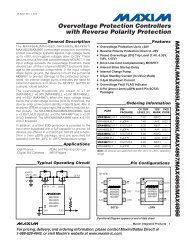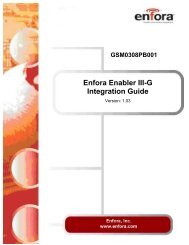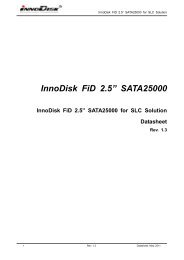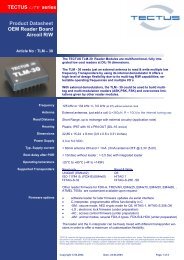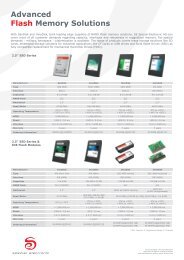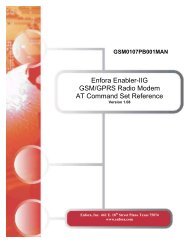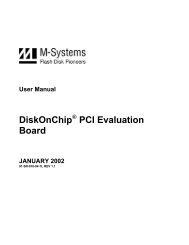AT+i Programmer's Manual - SE Spezial-Electronic AG
AT+i Programmer's Manual - SE Spezial-Electronic AG
AT+i Programmer's Manual - SE Spezial-Electronic AG
You also want an ePaper? Increase the reach of your titles
YUMPU automatically turns print PDFs into web optimized ePapers that Google loves.
Secure Socket Protocol Theory of Operation<br />
31 Secure Socket Protocol Theory of Operation<br />
31.1 Introduction<br />
iChip implements an SSL3/TLS1 client socket connection. When connecting to an<br />
SSL3/TLS1 server, iChip negotiates an SSL3/TLS1 secure connection. During the<br />
negotiation process, the server identifies itself to the client (iChip) by sending a<br />
certificate. The certificate‘s main purpose is to allow iChip to determine that the server is<br />
indeed the server it claims to be.<br />
To fulfill its purpose, the certificate contains the server‘s ID information (name, address,<br />
description, etc.) and its public key. It also contains a digital signature, signed by a thirdparty<br />
called a Certificate Authority (CA), which authenticates this information. The client<br />
must trust the CA in order to accept its signature on a certificate. Furthermore, the trust<br />
relationship between the client and the CA must be established prior to the<br />
communication session and preferably using alternate methods. iChip‘s CA parameter is<br />
used to store the CA‘s certificate. Once a trusted CA‘s certificate is stored on iChip, it<br />
will accept certificates signed by that CA from SSL3/TLS1 servers it connects to.<br />
31.2 Generating Certificates for Use with Servers<br />
The most common way to obtain a certificate is to buy one from a commercial certificate<br />
authority. This results in a public key that has been digitally signed by a trusted thirdparty.<br />
Any clients receiving this certificate can be sure they are communicating with an<br />
authentic entity. However, in a trusted environment, it is possible to create an in-house<br />
CA and to self-sign the certificate.<br />
Commercial CA‘s are usually preferred when connecting to multiple unknown servers.<br />
However, in distributed system configurations where not more than a handful of secure<br />
servers are deployed; an in-house CA is probably more appropriate and just as secure.<br />
Several free software packages are available for generating certificates. The following<br />
sections describe how to use the standard OpenSSL package to generate certificates. They<br />
contain instructions on how to obtain your own certificates suitable for use with servers<br />
to which iChip will connect. Furthermore, most FTP servers that support SSL3 include a<br />
certificate generation utility that may be used to generate self-signed certificates. The<br />
self-signed certificate is part of the FTP server‘s configuration and may also be loaded<br />
into iChip to allow it to connect to that FTP server using SSL3 secure sockets.<br />
31.3 Using the OpenSSL Package to Create Certificates<br />
OpenSSL is a widely used SSL toolkit available for free download at<br />
http://www.openssl.org. The SSL toolkit contains source code that can be compiled for<br />
Unix, Linux, or Windows. Pre-compiled binaries are also available for these platforms.<br />
OpenSSL comes with a command line utility for generating keys, creating CA‘s, and<br />
creating certificates.<br />
The following instructions assume the OpenSSL package has been installed and<br />
configured properly on your machine. The instructions walk you through using OpenSSL



